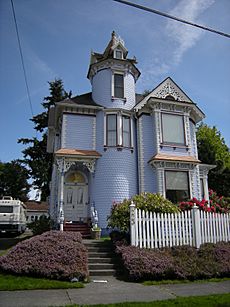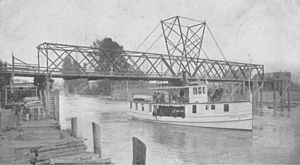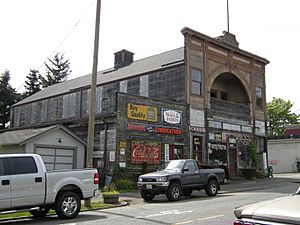Snohomish, Washington facts for kids
Quick facts for kids
Snohomish
|
|
|---|---|
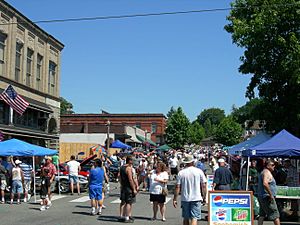
First Street during the annual Kla-Ha-Ya Days celebration, 2006
|
|
 |
|
| Country | United States |
| State | Washington |
| County | Snohomish |
| Founded | 1859 |
| Incorporated | June 26, 1890 |
| Government | |
| • Type | Mayor–council |
| Area | |
| • Total | 3.72 sq mi (9.64 km2) |
| • Land | 3.52 sq mi (9.12 km2) |
| • Water | 0.20 sq mi (0.52 km2) 4.44% |
| Elevation | 66 ft (20 m) |
| Population
(2010)
|
|
| • Total | 9,098 |
| • Estimate
(2019)
|
10,154 |
| • Density | 2,883.84/sq mi (1,113.35/km2) |
| Time zone | UTC-8 (PST) |
| • Summer (DST) | UTC-7 (PDT) |
| ZIP codes |
98290, 98291, 98296
|
| Area code | 360 |
| FIPS code | 53-65170 |
| GNIS feature ID | 1531910 |
Snohomish is a city in Snohomish County, Washington, United States. The population was 9,098 at the 2010 census. It is located on the Snohomish River, southeast of Everett and northwest of Monroe. Snohomish lies at the intersection of U.S. Route 2 and State Route 9. The city's airport, Harvey Airfield, is located south of downtown and used primarily for general aviation.
The city was founded in 1859 and named Cadyville for pioneer settler E. F. Cady and renamed to Snohomish in 1871. It served as county seat of Snohomish County from 1861 to 1897, when the county government was relocated to Everett. Snohomish has a downtown district that is renowned for its collection of antique shops and is listed on the National Register of Historic Places.
Contents
History
Snohomish was founded around 1858 by Emory C. Ferguson, E. F. Cady and others. It was originally known as Cadyville, and changed its name to Snohomish City in 1871. The name Snohomish comes from the name of the dominant local Native American tribe "sdoh-doh-hohbsh", whose meaning is widely disputed.
One of the first inland cities in the Puget Sound region, Snohomish was built where a planned military road connecting Fort Steilacoom and Fort Bellingham was set to cross the Snohomish River. The road, proposed in the wake of the Pig War, was intended to be built far enough inland to be safe from British naval attacks. Although the road was never completed, Snohomish quickly became a center of commerce in the expanding region. In 1861, Snohomish County separated from Island County and the Village of Snohomish was voted the county seat. It remained so until 1897 when the county seat was relocated to the larger, yet much newer neighboring city of Everett, Washington after a controversial and contested county-wide vote.
Snohomish's first school was organized in either 1867 or 1869. The city was finally incorporated in 1890 with Hyrcanus Blackman (who had, since 1888, been Police Chief with the monthly salary of $20.00 plus $2.00 for each arrest) as mayor. 1893 saw the construction of a roller skating rink and 1894 the first graduations from Snohomish High School. By 1899 the city of Snohomish was a prosperous town with a population of 2,000, 25 businesses and 80 homes.
1901 brought Snohomish the first motor car in the county. In 1903 First Street was paved with brick. When it was finished, there was a three-day celebration, and for years afterward, the city's residents remained so proud of the street that they washed it every week with a fire hose.
Emma C. Patric was appointed the town's first librarian in 1901, an event that lead to the 1910 grand opening of the town's first public library, The Carnegie Library. It is now the oldest remaining public building in the city. In 1911 a disastrous fire struck First Street and everything between Avenues B and C was destroyed. The fire began when a small blaze in the Palace Cafe on the South side of the street got out of control on Memorial Day, 1911 at about four a.m. Thirty-five business structures were put out of business, with $173,000 worth of goods destroyed. Despite the disaster the town continued to grow and by 1920 the population grew to a little over 3,000. The population would remain relatively stable for the next 40 years.
The Great Depression was not acutely felt in Snohomish because its economy was mostly agrarian with many family farms. One of the town's largest employers, Bickford Ford, was founded in 1934 by Lawrence Bickford; the dealership flourished in a period when many auto dealerships failed. The 1930s brought Snohomish national notice as the hometown of baseball great Earl Averill, the only Washingtonian in the Baseball Hall of Fame. Averill played from 1929 to 1941, mostly with the Cleveland Indians.
The 1960s saw the city of Snohomish enter a period of decline. As the Boeing Company fell on hard times, many people were laid off and had to move away to seek other work. A commonly heard phrase was, "Will the last person out of Seattle please turn off the lights?" Snohomish fought back with a redevelopment plan in 1965 that proposed the destruction of the historic structures along First Street to make way for an enclosed mall. The plan was not carried out due to lack of funds, and the area remains today as it has through much of its history.
The town's economic malaise continued throughout much of the '70s, with the downtown area given over to mostly bars and small shops. In 1973 the city adopted a Historic District Ordinance protecting historic buildings and structures from inappropriate alterations and demolitions and encouraging the design of new construction in keeping with the district's historic character. In 1974, the Historic Business District, a 36-block area, was placed on the National Register of Historic Places. Larger stores moved away from First Street into newer developments and strip malls that spread out along Second Street and Avenue D.
In 1974 the Seattle-Snohomish mill was gutted by fire and rebuilt by its owners. In 1975 a severe flood struck the area, damaging over 300 homes and killing 3,500 head of livestock, but the community rallied to support those who were affected. 1976 and '78 brought added community spirit as Snohomish High School won the AAA State football Championships under coach Dick Armstrong.
The 1980s saw renewed vigor in Snohomish when, along with other developments, two 7-Eleven convenience stores and a McDonald's franchise opened during the first part of the decade. In 1981, Richard Pryor came to town to film parts of the movie Bustin' Loose. Snohomish received additional attention from Hollywood in the 1983 movie WarGames as the name of the high school from which character David Lightman (played by Matthew Broderick) hacks into a military computer system. (The actual school that appears in the film is El Segundo High School in El Segundo, California.)
Around 1985, the U.S. Route 2 bypass was completed, allowing traffic which had until then been forced to pass through the town to circumvent the city. This greatly eased the gridlock which had been a part of everyday life and allowed the city to assume the more peaceful character it has today.
In the 1990s, First Street was redeveloped to take advantage of its historic buildings as a tourist attraction. Its sidewalks were rebuilt and public restrooms added. The city hall and police station were moved away from First Street and a new fire station was built, allowing those historic buildings to be renovated as well.
Today, Snohomish is a model of how cities can reinvigorate their business districts by preserving their historic charm. It has continued to grow, with much of its development spread out along the former Route 2, now known as Bickford Avenue. Snohomish has conscientiously maintained a balance between its regular businesses in modern facilities, serving the local community, and the specialty shops in the town's historic areas, serving visitors.
Geography
Snohomish is located at 47°55′9″N 122°5′28″W / 47.91917°N 122.09111°W (47.919131, -122.090978).
According to the United States Census Bureau, the city has a total area of 3.60 square miles (9.32 km2), of which, 3.44 square miles (8.91 km2) is land and 0.16 square miles (0.41 km2) is water.
Demographics
| Historical population | |||
|---|---|---|---|
| Census | Pop. | %± | |
| 1880 | 149 | — | |
| 1890 | 1,903 | 1,177.2% | |
| 1900 | 2,101 | 10.4% | |
| 1910 | 3,244 | 54.4% | |
| 1920 | 2,985 | −8.0% | |
| 1930 | 2,688 | −9.9% | |
| 1940 | 2,794 | 3.9% | |
| 1950 | 3,094 | 10.7% | |
| 1960 | 3,894 | 25.9% | |
| 1970 | 5,174 | 32.9% | |
| 1980 | 5,294 | 2.3% | |
| 1990 | 6,499 | 22.8% | |
| 2000 | 8,494 | 30.7% | |
| 2010 | 9,098 | 7.1% | |
| 2019 (est.) | 10,154 | 11.6% | |
| U.S. Decennial Census U.S. Census Estimate (2019) |
|||
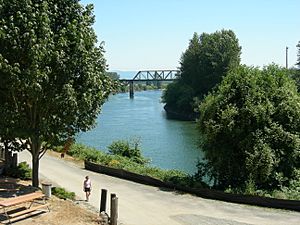
2010 census
As of the 2010 U.S. census, there were 9,098 people, 3,645 households, and 2,259 families residing in the city. The population density was 2,644.8 inhabitants per square mile (1,021.2/km2). There were 3,959 housing units at an average density of 1,150.9 per square mile (444.4/km2). The racial makeup of the city was 89.0% White, 0.5% African American, 1.1% Native American, 2.1% Asian, 0.3% Pacific Islander, 3.6% from other races, and 3.5% from two or more races. Hispanic or Latino of any race were 8.0% of the population.
There were 3,645 households, of which 34.8% had children under the age of 18 living with them, 40.5% were married couples living together, 15.4% had a female householder with no husband present, 6.1% had a male householder with no wife present, and 38.0% were non-families. 30.2% of all households were made up of individuals, and 9.8% had someone living alone who was 65 years of age or older. The average household size was 2.41 and the average family size was 2.99.
The median age in the city was 37.8 years. 24.3% of residents were under the age of 18; 8.4% were between the ages of 18 and 24; 27.7% were from 25 to 44; 27.9% were from 45 to 64; and 11.7% were 65 years of age or older. The gender makeup of the city was 48.2% male and 51.8% female.
Education
The Snohomish School District operates public schools that serve residents of Snohomish and nearby unincorporated areas, including Cathcart, Machias, and Three Lakes. As of 2020[update], the district has a total enrollment of 9,421 students, 488 teachers, and 18 total schools. It has two conventional high schools, Snohomish High School and Glacier Peak High School, and an alternative high school program. These high schools are fed by two middle schools, which in turn draw from ten elementary schools. The district is governed by a five-member school board and had a budget of $154 million for the 2020–21 school year.
The Snohomish area also has several private schools operated by churches and other organizations. The St. Michael Catholic Church founded its parish school in 2007, becoming the sixth in Snohomish County operated under the Archdiocese of Seattle. Other Christian schools include Lighthouse Christian Academy, the Academy of Snohomish, and Zion Lutheran School.
Infrastructure
Transportation
Snohomish is bisected by two major highways: U.S. Route 2 (US 2), which bypasses the city to the north and east, continuing on to Everett and Stevens Pass; and State Route 9, which runs north–south and connects to Woodinville and Lake Stevens. Other major roads in Snohomish include Bickford Avenue (which continues south as Avenue D), which formerly carried US 2 and is named for a local car dealership, Machias Road (Maple Avenue), and 2nd Street (92nd Street).
Community Transit, the countywide public transit authority, provides bus, paratransit, and vanpool service to Snohomish from surrounding cities. Two routes travel from Everett Station (with limited service to the Boeing Everett Factory) to Snohomish and continue east along US 2 to Monroe, Sultan, and Gold Bar. Another route travels from Lynnwood and Mill Creek to Snohomish and follows the State Route 9 corridor north to Lake Stevens. Community Transit also operates a commuter bus route that connects Snohomish and Monroe to Downtown Seattle with intermediate stops on Interstate 405 and State Route 520. The city has one park and ride lot, located near Avenue D and State Route 9, that is owned by the Washington State Department of Transportation (WSDOT).
The city was formerly served by the Everett–Snohomish Interurban, an electric interurban railway that ceased operations in 1921. A small replica train depot was opened in 2005 near the Avenue D Bridge to serve as a visitors center.
A privately-owned airport, Harvey Airfield, is situated to the south of downtown Snohomish. It was established in 1944 and remains under the ownership of the Harvey family. The airport is generally used for general aviation and small businesses, including skydiving clubs and hot air balloon operators.
Utilities
Utility services for residents and businesses in Snohomish are split between the city government and other providers. The Snohomish County Public Utility District provides electric power to customers Snohomish and most of the county, while Puget Sound Energy supplies natural gas. The city government contracts with Republic Services for collection and disposal of curbside garbage, recycling, and yard waste. Since the closure of the Cathcart Landfill near Snohomish in 1992, garbage is generally sent to a landfill in Roosevelt for processing and burial.
The city government manages tap water service within Snohomish, which is delivered through a 35-mile (56 km) system of pipes. The city purchases 90 percent of its water from the City of Everett, which sources from Spada Lake and the Sultan River basin; the remainder is purchased from the Snohomish County Public Utility District, which treats well water near Lake Stevens. The city government operated its own water treatment plant on the Pilchuck River near Granite Falls until 2017, when it was determined to be too costly to maintain.
Snohomish's wastewater system consists of a combined overflow for downtown and other older neighborhoods and a separated sewage and stormwater system for the rest of the city. A plan to replace the combined overflow system was approved in 2014 following interventions by the Washington State Department of Ecology. The city's wastewater treatment plant on the Snohomish River was upgraded, replacing an earlier proposal to send sewage to the City of Everett for treatment.
See also
 In Spanish: Snohomish (Washington) para niños
In Spanish: Snohomish (Washington) para niños


